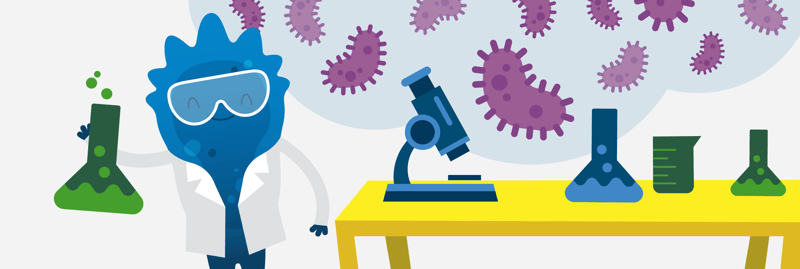A recent survey of PhDs found that many researchers feel they lack formal training in a variety of transferable skills. At Addgene we're helping to fill this gap by both helping researchers recognize their MANY transferable skills learned while working in the lab and offering advice on areas where you might need some help. Today, we’re highlighting an oft-underlooked transferable skill: creativity.
I’ve heard quite a few scientists state that they’re not creative, usually saying that they’re not artists, or artistic, and therefore not creative. However, if we think of creativity as a form of innovation, it’s clear that creativity is absolutely a transferable skill developed during PhD training. Creativity is required to develop new projects and test novel approaches, a necessary skill set for any scientist. In this blog, we’ll delve into strategies you can use to foster innovation. If you identify as a non-creative or if you find yourself in a creative rut, read on!
 |
| Fig 1: Blugene using creative problem-solving in the lab |
Thinking Outside the Box: Individual Approaches
Whether it’s finding the source of contamination or figuring out why the lab is so cold, we’ve all had to think creatively to solve a problem. But how do you intentionally engage in a creative problem-solving process?
You may want to start by carving out time to tackle it. It’s easy to get distracted by an email or sidetracked by a colleague. To innovate, you’ll have to focus. Find yourself a block of time and a quiet space where you can address the issue head on. Prepare for this time as if it were a meeting. Gather the resources you’ll need ahead of time and mute your notifications during. (Boyes, 2019)
If you’ve taken the time to do this and are still struggling with idea generation, try this thought exercise: Consider the issue as if there were no restraints on your problem-solving resources. What would you do if you had all the funding in the world? What if you could hire more people? What would you do with unlimited time?
Another strategy for your brainstorm session is to start with something completely unrelated to the issue and consider how it could be shaped to solve your problem. In a study outlined in Originals by Adam Grant, a creativity expert at Stanford conducted an experiment in which people were asked to create a device to help students during an interview. When they were instructed to use the three-ring binder as a starting point, the ideas generated were hardly novel. When told to use a roller skate as a starting point, their ideas scored 37% higher in originality.
It may not be easy to optimize virus production with roller skates—though I could get around the lab faster that way— but the idea behind the study holds. To generate novel ideas, start with an out-of-the-box concept and pare it down until you have something tangible and applicable to your situation.
Thinking Outside the Box: Team Approaches
At some point or another, you’ll find yourself needing to brainstorm with a team. One major challenge with these brainstorming sessions is avoiding groupthink, the tendency of a group of people to agree with the most prominent idea, and instead building an environment where everyone has their ideas heard.
So how can we assure that all participants feel comfortable sharing their ideas? And how do we give people the opportunity to speak out and prevent groupthink? Here are some ideas that I have found helpful in my team brainstorming sessions.
- Allow the group time to think about the problem before you meet. This holds the dual purpose of giving people time to process the issue properly while also discouraging everyone from agreeing with the first idea that is thrown out because they haven’t had time to process on their own. You may also find your meetings run smoother when people have thought about the issue ahead of time.
- Encourage dissent. The best way to encourage dissenting opinions is to foster a culture of inclusivity. Work with and value people who think differently from you and you will arrive at unique solutions to the same problem. If your lab/company/team is still working towards a culture of encouraging dissent, the next tip may be particularly relevant to you.
- Elect a devil’s advocate. This is the person whose job it is to disagree with the group. They are the ones who ask for rationales behind ideas and decisions while encouraging the group to think about alternative options. When a devil’s advocate is elected, others may feel they can share opposing opinions as well. I am sure we have all experienced a meeting where one person speaks up after a group consensus and is immediately followed by several other people with their own dissenting opinions or ideas. While the best devil’s advocate is one who truly disagrees with the group (because they will fight more adamantly for their solution), selecting a devil’s advocate is a good option for any meeting in which the goal is to generate unique ideas.
- Recognize ideas can come any time. Meetings shouldn’t be the only place people share ideas. Ideas had over lunch are just as valuable! In 2019, Addgene implemented a company-wide New Ideas Survey. Anyone could fill out the form at any time and a member of our Business Development team would review it. This survey generated 26 ideas, over half of which, when implemented, impacted the entire company. It is important to note that the person who submitted the idea did not have to be in charge of implementing it. The purpose of this form was to encourage the sharing of ideas, not to give people more work.
Identify your enemies
In Felicia Day’s book Embrace your Weird, Day identifies nine enemies that stand in the way of creative thinking. I won’t go through all nine here, but I’ll discuss a few that I frequently observe in a scientific setting.
Powerlessness
It’s hard to be creative when you don’t believe you have the power to change anything. You may not have the highest position or the longest tenure, but don’t let that stop you from speaking up.
If your ideas are not well received, understand that people can be resistant to change. Ask your peers or your superiors to explain their rationale when they’re resistant to new ideas. If their answer is “we’ve always done it this other way,” you probably have reason to continue advocating for your idea. Our product team has implemented a policy of never rejecting an idea simply because it's not how things were done in the past. As a result, the product team is an incredibly innovative group. Our entire company benefits from their policy!
Perfectionism
When we reach for perfection, our work stalls. We become so fixated with the idea of making something the best it can be that it seems impossible to start at all. This is why perfectionists tend to also be procrastinators.
If you fall into this category, get out of your head by giving yourself a quick, easy goal. For example, set a timer for five minutes and come up with as many solutions as you can in that timeframe. Tell yourself they don’t have to be perfect or even good. The goal is simply to throw out ideas.
When your five minutes are up, if you haven’t come up with any ideas obviously worth pursuing, evaluate the “bad” ones. Bad ideas are easier to work with than nothing at all - they’re still ideas, after all, and that is the goal of this exercise. If you can identify exactly why an idea won’t work and fix it piece by piece, you’ll slowly turn your unworkable idea into a viable solution.
Anticipate Change
Just because a process is working, doesn’t mean it will always be that way. Things change and processes often have to change with them. If you can, set aside time to prepare for future challenges. This doesn’t have to be time-consuming or even very frequent, but establishing a few minutes every month dedicated to thinking about the future will improve your ability to innovate. (Finkelstein, 2019)
One issue currently plaguing the scientific community is supply chain shortages. When flasks, conical tubes or pipette tips are backordered for months, we have to have plans in place to be able to continue our experiments. Thinking about these plans before you’ve run out of consumables is key to keeping your science going throughout these challenging times.
Take a Break!
If all else fails, one of the best things you can do for yourself when you’re stuck on a problem is to step away from it. Find something unrelated to do (many Addgenies enjoy rock climbing, for example) and let your brain do some thinking in the background while you enjoy your day. If you’re in a time crunch, your break can be as simple as a few minutes of meditation or a walk to the break room for a sip of water.
 |
| Fig 2: Blugene likes to spark creativity in out on the open sea |
Creativity comes in many forms. Whether you can paint like Frida Kahlo or you’re stuck drawing stick figures, remember your training as a scientist has been building your creativity all along. In my own career, my team has used these techniques to optimize our lab space, our protocols and even our Lab Inventory Management system. I hope these tips help you to see that the creative skills you have developed in the lab can be applied anywhere!
References and Resources
References
Grant, A. (2017). Originals how non-conformists move the world. Penguin Publishing Group.
Day, F. (2019). Embrace your weird face your fears and unleash creativity. Gallery Books.
Boyes, A. (2019, November 13). 5 mental mistakes that kill your productivity. Harvard Business Review. Retrieved January 14, 2022, from https://hbr.org/2019/11/5-mental-mistakes-that-kill-your-productivity
Finkelstein, S. (2019, July 15). A brief exercise to spur innovation on your team. Harvard Business Review. Retrieved January 14, 2022, from https://hbr.org/2019/07/a-brief-exercise-to-spur-innovation-on-your-team
Additional Resources on the Addgene Blog
Transferable Skills Guide: Problem-Solving
Transferable Skills Guide: Teamwork
Transferable Skills Guide: Identifying Your Transferable Skills
Topics: Transferable Skills





Leave a Comment